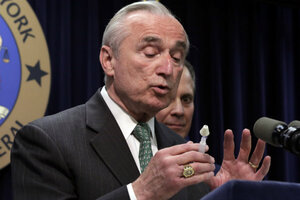Heroin epidemic: New York becomes first big city to make cops carry antidote
Facing a 'growing epidemic' of heroin abuse, first responders in New York City, including police and firefighters, are now being equipped with nalaxone antidote kits in a bid to save lives.

New York City Police Commissioner William Bratton (l.), accompanied by New York Attorney General Eric Schneiderman, discusses an inhaler of naloxone, one of two included in an Overdose Prevention Rescue kit, during a news conference in New York on Tuesday.
Richard Drew/AP
NEW YORK
Continuing to respond to what officials around the country are calling a “growing epidemic” of heroin abuse in the US, New York City law enforcement officials announced Tuesday that city cops would begin to carry antidote kits for those who overdose on the opiate-based drug.
Police Commissioner William Bratton announced that his department would join a $5 million effort set up last month by New York Attorney General Eric Schneiderman. Police officers will be equipped and trained to use a nasally administered “naloxone kit” – the spray version of a drug antidote that revives those who may have taken a fatal dose of heroin or a similar opiate.
The naloxone antidote program – now being adopted by the nation’s largest police force – follows the groundbreaking work of the police department in Quincy, Mass., which became the first department in the nation to require its officers to carry naloxone back in fall of 2010. Since then, Quincy police officers have saved the lives of 211 of 221 people who overdosed on heroin or opioids, officials say.
In suburban Suffolk County, the heavily populated area east of New York City in Long Island, nearly 600 lives were saved last year, Attorney General Schneiderman said Tuesday, while a pilot program in Staten Island, the borough where the city has seen its highest rates of overdoses, has also saved at least 42 lives since it began last month.
Calling naloxone “stunningly effective,” Schneiderman called the new program “an essential part of our effort to combat the spike in heroin overdoses that is plaguing communities and families here in New York City and across the state.... This program will literally save lives.”
Tuesday’s announcement comes as city officials report an 84 percent increase in the number of fatal overdoses between 2010-12, after four years of decreasing numbers. Indeed, overall heroin use has skyrocketed nationwide in the past five years, nearly doubling as the National Survey on Drug Use and Health reports nearly 670,000 users in 2012, up from 373,000 in 2007.
The naloxone antidote is hardly new, however, and New York City paramedics, like others around the country, have carried kits like these for decades. But now officials are equipping cops and firefighters with such antidote kits, since they are usually the first responders in emergencies involving fatal overdoses, in which every minute counts.
Indeed, last month the New York City Fire Department also announced that all emergency medical technicians and firefighters would now carry the life-saving drug. Paramedics administered the naloxone antidote more than 2,800 times citywide in 2013, officials say.
But these moves to include more cops to treat overdoses onsite follows a perfect storm of trends that have converged to make heroin more and more the opiate of choice for a growing new demographic of users.
No longer the stereotype of a shivering urban junkie, heroin users are now found among the working and professional classes, including suburban abusers of opiate-based painkillers like oxycodone. Faced with higher prices and shortages in the illegal market for pills, these now seek out what street users often refer to as “smack.”
Indeed, as the illicit use of painkillers has become more difficult with stricter regulations and law enforcement – which has led to a corresponding low supply and higher price, officials say – users have turned to heroin for a cheaper and more readily available high. And Mexican cartels, funneling heroin from Colombia, have been flooding the market with a purer and cheaper product.
And with its higher purity, users can now snort the drug, officials say, rather than cook and shoot it with needles – a well-known pop-cultural image that has scared away many first-time users in the past.
New York law enforcement officials have also been seizing more heroin in the first few months of 2014 than they did in all of 2013. Drug agents have taken nearly 300 pounds of heroin off the streets so far this year, compared to 175 pounds last year – and already the most seized in one year since 1991.
But with the growing number of users coming from a more wealthy professional and suburban demographic, more money is now being directed toward such life-saving measures than in the past. In addition, cops mostly forgo making arrests for any drugs found on those who overdose.
“We can't arrest our way out of a drug problem,” tweeted the NYPD after the Tuesday news conference. “Naloxone gives individuals a 2nd chance to get help.”
In New York, each kit will cost the city $60, and will include two doses of the naloxone antidote with a shelf life of two and a half years. The $5 million program will be partially funded by money seized from drug dealers, Schneiderman said. New York City police will receive about $1.2 million for kits and training, he said, while more than 150 other law-enforcement agencies throughout the state are set to begin the program.
“This past weekend, #naloxone saved 2 lives in #StatenIsland,” tweeted Schneiderman Tuesday. “Now all @NYPDnews cops – often 1st on the scene of OD – will have that ability.”

